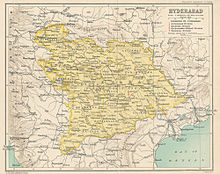Annexation of Hyderabad

Operation Polo was the military operation of annexation of the princely Hyderabad state into India, by the Indian Army in September 1948. It was the first and the largest police action undertaken in Independent India.
The dispute
Main Articles: Political Integration of India, Partition of India
Hyderabad State stretched over 82,000 square miles in the heart of India and with a population of 16 million, 85% of whom were Hindus. The area covers parts of what is now states of Maharashtra, Karnataka, Orissa and Tamil Nadu, and covered most of Andhra Pradesh.
Its ruler was Nizam Osman Ali Khan, Asif Jah VII. Hyderabad had always enjoyed an influential relationship as the largest and most loyal ally of the British Raj. Under the influence of Muslim radical Qasim Razvi, the Nizam sought independence for Hyderabad as a dominion in the British Commonwealth. When the British ruled out this possibility, the Nizam set his mind upon independence, and refused to sign the instrument of accession.
To Sardar Patel, Hyderabad was more important than Kashmir. Without Hyderabad, there would be a big gap in the stomach of India, and Patel knew that Hyderabad was looking to Pakistan for political and military support.
While Sardar Patel made it clear that Hyderabad was essential, he agreed with Lord Mountbatten that force should not be used immediately. A Standstill Agreement was signed, maintaining a status quo - a concession made to no other princely state without an explicit assurance of eventual accession. But Patel allowed Hyderabad to only guarantee that it would not join Pakistan.
Mountbatten and K.M. Munshi, India's envoy attempted to engage the Nizam's envoys Laik Ali and Sir Walter Monckton into negotiations on an agreement. But Hyderabad continually reneged on possible deals meted out by Mountbatten. Hyderabad also protested that India had created an armed barricade to isolate it economically. India charged that Hyderabad was receiving arms from Pakistan, and that the Nizam was allowing Razvi's fundamentalist Razakars to intimidate Hindus and attack villages in India. Hyderabad also attempted to obtain the arbitration of the United Nations and the President of the United States, unsuccessfully.
Mountbatten crafted the Heads of Agreement deal and attempted in June, 1948 to obtain Patel's signature. The agreement called for the disbandment of the Razakars and restrict the Hyderabad army, and for the Nizam to hold a plebiscite and elections for a constituent assembly. While India would be empowered to control Hyderabad's foreign affairs, the deal allowed Hyderabad to set up a parallel government structure that could have enabled it to obtain the same level of a dominion, and perhaps declare independence.
Sardar Patel signed the deal, only knowing that the Nizam would renege on the plan despite it favoring Hyderabad. The Nizam reneged and Mountbatten's plan fell flat.
The operation
Sardar Patel made it clear that India would take no more. He obtained the principal agreement of Governor-General Chakravarti Rajagopalachari and Prime Minister Jawaharlal Nehru after some contentious debate, and under Operation Polo, sent the Indian Army to liberate Hyderabad. Between September 13th and 18th, Indian troops fought back Hyderabadi troops and Razakar militants.
Operation Polo as it was called was launched on September 12, 1948. The Indian Army backed by the Indian Air Force surrounded the Nizam's territory. Nizam's Army and 200,000 Razakars (similar to Stormtroopers) expected dhoti clad soldiers, a caricature of the Hindus who lived in their dominion. Razakars had famously claimed that they would not only beat the Indian Army, but hoist the Nizami flag from the ramparts of Red Fort (located in Delhi).
The army attacked from all fronts encircling the Hyderabad State forces and the notorious Razakars. Within five days Hyderabad was secured by Indian Army. The Indian Army suffered 22 casualties and 97 soldiers injured, Razakars and Nizam's army suffered 882 casualties and thousands injured.
Aftermath
Unfortunately, the annexation of Hyderabad was followed by an orgy of communal violence. As reports of atrocities being committed against the Muslim minority reached Delhi, Prime Minister Jawaharlal Nehru commissioned an unofficial report from a group of veteran Congressmen made up of two Hyderabadi Muslims who had prominently opposed the Nizam's rule and chaired by a Hindu, Pandit Sunderlal. After extensively touring the state, the committee presented its report, entitled "On the Post-Operation Polo Massacres, Rape and Destruction or Seizure of Property in Hyderabad State," to Nehru and Patel in January 1949. In village after village across the state, the report catalogued incidents of murder and mass rape, sometimes carried out by troops, in other cases committed by Hindu mobs after troops had disarmed the Muslim population. Ultimately, according to the report, an estimated 200,000 Hyderabadi Muslims were slaughtered in the aftermath of Operation Polo. The fall of Hyderabad and the ensuing bloodbath also sparked a mass exodus to Pakistan among the state's Muslim population.
Following the successful operation by the Indian army, the Telugu speaking area was joined to Andhra Pradesh while the western portion was merged with Karnataka state. The Army's success paved the way for further acquisitions by force against any other pockets of resistance like Goa.
Patel however retained the Nizam as the head of state, while Maj. General J.N. Chaudhari became the military governor. Qasim Razvi was placed under house arrest. Years later, he immigrated to Pakistan.
It is suggested that the main aim of Mountbatten and Nehru in avoiding a forced annexation was to prevent an outbreak of Hindu-Muslim violence. Patel insisted that if Hyderabad was allowed to continue with its antics, the prestige of the Government would fall and neither Hindus nor Muslims would feel secure in its realm. The successful integration of Hyderabad was in fact praised by many Indian Muslim leaders, and the giant stature of Sardar Patel grew even further. There were no episodes of communal violence.
External link
- Bharat Rakshak
- Patel: A Life by Rajmohan Gandhi
